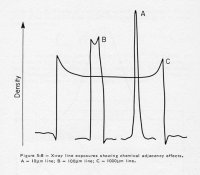A contact printed resolution target tells you both limit resolution and which image property dominates that limit. It is entirely up to you whether you favour sharpness over grain, but you'd rather make an informed decision than rely on anecdotal evidence or marketing drivel.
Realistic shooting conditions won't give you more than 100 lp/mm. To give you an impression:
- For 100 lp/mm your CoC can't be larger than 2-3 µm, which means you have about 1/10 of DoF which you would normally have, e.g. a 50mm lens at F/2.8 and 3m subject distance would have 4cm of total DoF). Good luck getting focus sufficiently accurate, and subject matter with less depth.
- Because of diffraction limits, you have to shoot at F/2.8 or larger aperture if you want 100 lp/mm. Few medium format lenses open up to F/2.8, and even fewer large format lenses. Very few small format lenses reach 100 lp/mm at F/2.8 or larger.
Extend this argument to resolutions beyond 100 lp/mm and see what you get. 200 lp/mm would require you to shoot at F/1.4 and give you 1 centimeter of DoF in the example above.
Now if we look at the
Zeiss document where they claim 400 lp/mm at F/4: we can safely assume that these 400 lp/mm come at a significant loss of contrast, which is ok with test charts, but not ok with real world image matter.
There are
some tricks to increase perceived sharpness of an image, and several popular developer formulas put these to use. These tricks don't increase real resolution, but fake the impression of a very sharp image, just like unsharp masking. Like the latter, these developers usually create stronger granularity. And that's where Adox CMS 20 film becomes useful: even if you boost its grain a great deal, it's still finer grained than what your lens can handle, and together with a sharpness enhancing developer you can create very fine grained
and very sharp looking images, albeit at ISO 20.


 . But it's the least expensive method I can think of.
. But it's the least expensive method I can think of.


